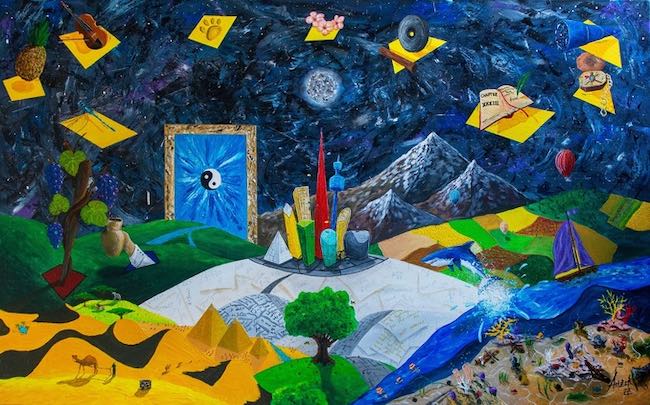Lo sguardo sul mondo determina la modalità con cui si affronta la quotidianità e anche quella sulla base della quale si interpretano gli accadimenti, le circostanze che si susseguono e che a volte sembrano capitare in maniera disordinata nell’esistenza determinando confusione e caos; allo stesso modo la capacità espressiva degli artisti si conforma proprio al singolare e unico modo di guardare la realtà, dando vita a un personale approccio che diviene la manifestazione di quell’essenza. E poi ci sono altri creativi che hanno bisogno di andare oltre, di osservare tutto da un’angolazione diversa che produca un’interpretazione bizzarra e stravagante di ciò che attraversa la quotidianità. Il protagonista di oggi appartiene a questo gruppo di originali artisti che riescono a far emerge quel senso di caos attraverso cui lo sguardo tende a mettere ordine prima di cominciare a cercare un senso più profondo.
Nel momento in cui si delinearono le linee guida del movimento forse più inquietante, misterioso e impertinente dei primi anni del Ventesimo secolo, quel Surrealismo che aveva deciso di lasciar emergere tutte le angosce, i turbamenti della psiche nascosti dalla razionalità ma affioranti invece nella fase onirica, il mondo culturale dell’epoca, scandalizzato dalle immagini sessuali, mostruose e sconvolgenti di Salvador Dalì e di Willem den Broeder, disgustato dalle atmosfere postapocalittiche e dai mostri di Yves Tangui e di Max Ernst, dimenticava che vi erano stati nel passato grandi precursori di questo movimento che probabilmente costituirono base di partenza per lo studio dei maestri poc’anzi citati. Già nell’Olanda del Cinquecento un artista si discostò completamente dallo stile Fiammingo che contraddistingueva la produzione artistica di quel tempo e stravolse i benpensanti e i salotti culturali con le sue grandi opere scomposte, prive del senso della prospettiva e completamente invase di elementi attraverso i quali derideva la morale cattolica dell’epoca che, a suo dire, non faceva che provocare frustrazioni nell’individuo. Tale coraggioso pittore risponde al nome di Hieronymus Bosch ed è di fatto l’iniziatore di tutto quel percorso di ulteriore approfondimento compiuto dai surrealisti. Qualche secolo dopo, intorno al Settecento, un altro creativo, William Blake, andò contro le regole espressive del Romanticismo, genere a cui di fatto è associato, dando vita una visione particolare, in particolar modo nell’illustrazione della Divina Commedia in cui diede vita a mostri spaventosi, creature soprannaturali sullo sfondo di paesaggi irreali; e infine Odilon Redon, esponente del Simbolismo, nel suo caso declinato nell’accezione più irreale, nelle cui opere litografiche gli occhi si trasformano in figure geometriche o in misteriosi pianeti, dove i volti diventano il corpo di ripugnanti insetti e dove gli ambienti sono completamente decontestualizzati e desolanti. Dunque il Surrealismo fu di fatto l’evoluzione delle linee tracciate da questi visionari innovatori che seppero imporsi in epoche in cui non si era ancora verificata la rottura netta con l’arte tradizionale che poi invece contraddistinse il Novecento. L’artista di origine slovena Anže Ivanuš, in arte Anžo, sembra attingere a ognuno di questi grandi maestri del passato, prendere spunti sulla base del proprio istinto creativo, mescolare il Surrealismo alla gamma cromatica intensa e irreale dell’Espressionismo ed epurare le sue opere dal senso inquietante e spaventoso presente negli autori del Ventesimo secolo per assecondarlo al suo approccio alla vita, entusiasta, vivace e anche fortemente ironico.
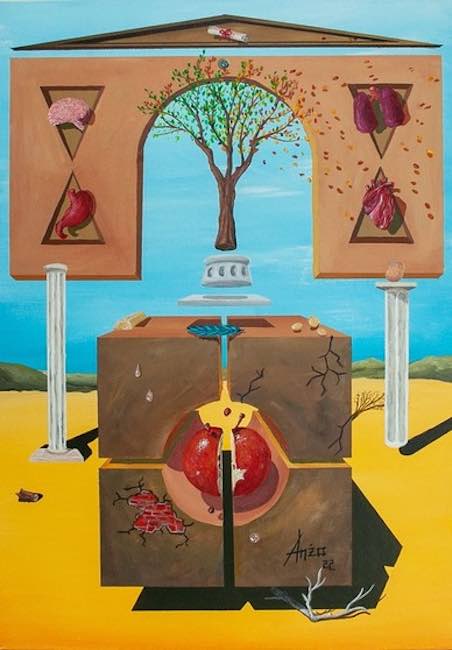
Perché è solo attraverso la capacità di sorridere e di prendersi in giro che è possibile andare oltre ciò che accade e le sensazioni seriose e a volte pesanti che genera, per analizzare con un utile distacco e con un sano scherno tutto ciò che entra a far parte dell’esistenza, a partire dagli oggetti di uso comune per finire a frutta e ortaggi che sembrano vivere di vita propria. La disposizione degli elementi che compongono le opere è molto vicina a quella di Hieronymus Bosch, dando la sensazione che tutto fluttui all’interno di un tempo non tempo, dominante uno spazio non spazio dentro cui le cose, i simboli, i dettagli che inevitabilmente fanno parte della quotidianità si allontanano dal contesto in cui l’occhio è abituato a vederli per sottolineare una rilevanza troppo spesso trascurata, se non ignorata dall’individuo che dimentica di cogliere il lato magico e ludico dell’esistenza.
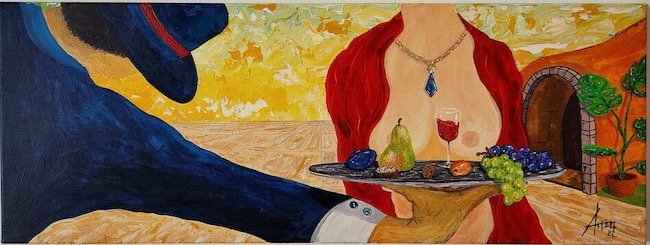
Il messaggio che si nasconde dietro ogni opera di Anže Ivanuš è quello di non perdere mai il contatto con il bambino all’interno di ciascuno, l’unico in grado di meravigliarsi, di ridere a squarciagola, di divertirsi con semplicità senza correre dietro a obiettivi da raggiungere, senza preoccupazioni e soprattutto con la capacità di trovare un senso, una vita propria, a ogni cosa che invece l’adulto perde divenendo pragmatico, spesso iperrazionale perdendo così di vista tutto ciò che rende l’esistenza più bella. Anže Ivanuš invece coltiva proprio quel lato sognatore, quello in grado di trasformare, come in una fiaba, ogni elemento in qualcosa di simile all’universo descritto da Lewis Carrol nel suo Alice nel Paese delle Meraviglie; nel caso dell’artista tuttavia sono gli oggetti a prendere vita, a conquistare un loro spazio completamente privo della presenza umana se non nel momento in cui quest’ultima viene evocata, o forse sarebbe meglio dire scimmiottata.
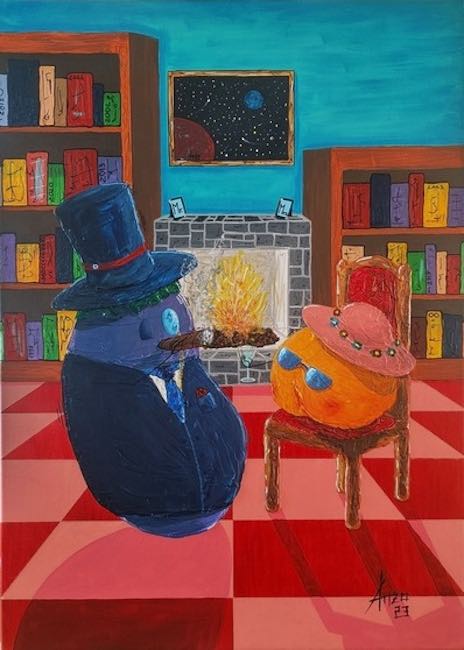
Come nell’opera Celebration by the fire, dove una melanzana e una pesca sono rappresentati vestiti il primo da distinto signore e la seconda da elegante dama, e sembrano festeggiare la loro capacità di essersi finalmente conquistati un ruolo primario, quello di protagonisti e non più solo trascurabili dettagli nella vita dell’uomo; l’ordine impeccabile della parete dietro di loro, piena di libri, testimonia un atteggiamento pacato e sereno, come se finalmente avessero trovato la realizzazione più completa mentre sopra il caminetto alle loro spalle spicca un quadro dello spazio profondo, indizio del possibilismo e dell’opzione che tutto sia semplicemente una visione onirica di un irriducibile eterno bambino.
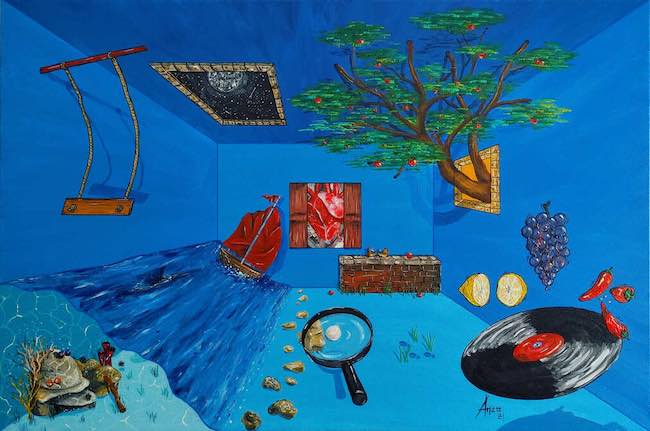
E infatti in Childhood dreams Anže Ivanuš entra nel mondo più surreale, quello infantile in cui gli oggetti vagano all’interno di una stanza in cui sono presenti tutti i dettagli che per l’artista, ma anche per l’osservatore, hanno costituito i passi, gli elementi fondamentali che hanno arricchito e divertito le sue giornate, come la natura, il mare, le barche, la clessidra, la lente di ingrandimento, l’altalena e la capacità di guardare le stelle, posizionate in una finestra sul soffitto, sognando di poterle toccare con un dito. La prospettiva della stanza sembra volersi ampliare per dare maggiore spazio ai ricordi, come fosse un cassetto della mente dove tutto è conservato dando possibilità all’essere umano di attingere a esso ogni volta che ve ne è il bisogno, perché in fondo è solo ricordando i giovani che siamo stati che siamo potuti diventare gli adulti di oggi, anche se a volte questo fatto innegabile sembra dimenticato dentro le pieghe della quotidianità.
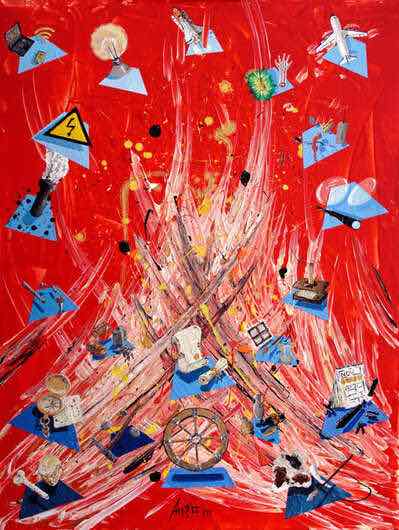
Nella tela Inventions l’artista ricorda e ripercorre tutti i simboli delle scoperte tecnologiche, mediche, scientifiche che hanno permesso l’evoluzione e il miglioramento della vita dell’essere umano; eppure non trascura di sottolineare quanto in realtà questa esplosione di progresso, come rappresentato dallo sfondo sfumato e pennellato in maniera indefinita del centro dell’opera, potrebbe invece aver condotto l’umanità a una disumanizzazione, all’incapacità di gestire nella maniera più corretta quegli oggetti e quelle nozioni secondo lo scopo per il quale erano stati creati. Dunque dalla meraviglia e la sorpresa di ciò che lo sguardo vede, e ha visto accadere nel corso dell’ultimo secolo, si aggiunge il velato monito di non lasciarsi sopraffare al punto di dimenticare il contatto intenso e profondo con la natura.
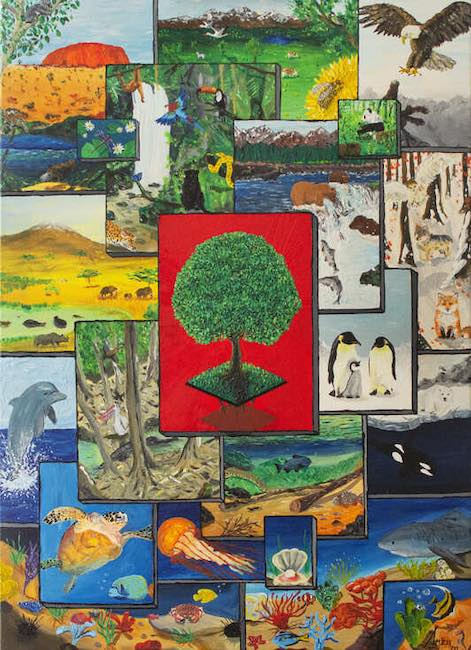
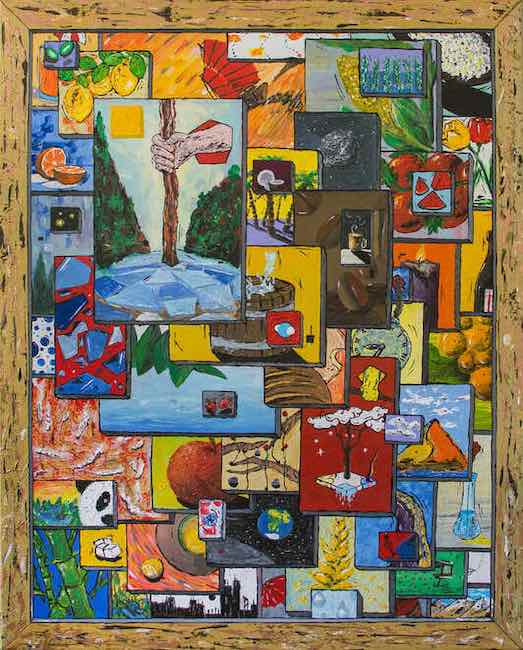
Ed è proprio a quest’ultima che Anže Ivanuš dedica le due opere Animal Kingdom ed Essence of Water che appaiono come un riassunto di tutti gli elementi essenziali alla vita non solo dell’uomo bensì dell’intero pianeta, una sorta di celebrazione di ogni singolo motivo per il quale dovremmo apprezzare ciò che essa ci dona, spesso senza chiederci nulla in cambio se non di lasciarla in pace senza compromettere il suo equilibrio. Anže Ivanuš, formatosi come autodidatta, dal 2015 a oggi ha tenuto nove mostre personali e partecipato a mostre collettive in Slovenia, Austria, Paesi Bassi e Croazia ed è uno degli artisti partecipanti alla mostra collettiva internazionale Vienna Art Summer 2023, presso la City Gallery Vienna, in programma dal 2 al 17 luglio.
ANŽE ANŽO IVANUŠ-CONTATTI
Email: blueverze@gmail.com
Sito web: https://blueverze.com/
Instagram: https://www.instagram.com/blueverze_art/
Facebook: https://www.facebook.com/anzoonelove
Linkedin: https://www.linkedin.com/in/an%C5%BEe-ivanu%C5%A1-46a05b82/
The Expressionist Surrealism of Anže Anžo Ivanuš, between irony and irreverence to observe things from an original point of view
The view of the world determines the way one deals with everyday life and also the way one interprets events, the circumstances that follow one another and that sometimes seem to occur in a haphazard way in existence, leading to confusion and chaos; similarly, the expressive capacity of artists conforms precisely to the singular and unique way of looking at reality, giving rise to a personal approach that becomes the manifestation of that essence. And then there are other creatives who need to go further, to look at everything from a different angle that produces a bizarre and extravagant interpretation of the everyday. Today’s protagonist belongs to this group of original artists who manage to bring out that sense of chaos through which the gaze tends to put things in order before beginning to search for a deeper meaning.
At a time when were being outlined the guidelines of perhaps the most disturbing, mysterious and impertinent movement of the early years of the 20th century, that Surrealism that had decided to let go out all the anxieties and disturbances of the psyche hidden by rationality but surfacing instead in the dream phase, the cultural world of the time, scandalised by the sexual, monstrous and disturbing images of Salvador Dali and Willem den Broeder, disgusted by the post-apocalyptic atmospheres and monsters of Yves Tangui and Max Ernst, forgot that in the past there had been great precursors to this movement who probably formed the basis for the study of the masters just mentioned. Already in the Netherlands in the 16th century, an artist made a complete departure from the Flemish style that characterised the artistic production of the time and upset the well-wishers and cultural salons with his large, disjointed artworks, devoid of a sense of perspective and completely invaded with elements through which he mocked the Catholic morality of the time that, in his opinion, only caused frustration in the individual. Such a courageous painter answers to the name of Hieronymus Bosch and is in fact the initiator of all that path of further deepening accomplished by the Surrealists. A few centuries later, around the 18th century, another creative artist, William Blake, went against the expressive rules of Romanticism, the genre with which he is in fact associated, creating a particular vision, especially in the illustration of the Divine Comedy in which he gave life to frightening monsters, supernatural creatures against the backdrop of unreal landscapes; and finally Odilon Redon, an exponent of Symbolism, in his case declined in the most unreal sense, in whose lithographic works eyes are transformed into geometric figures or mysterious planets, where faces become the bodies of repugnant insects and where environments are completely decontextualised and desolate. Thus, Surrealism was in fact the evolution of the lines drawn by these visionary innovators who were able to impose themselves in times when there had not yet been the clean break with traditional art that later characterised the 20th century. The Slovenian-born artist Anže Ivanuš, aka Anžo, seems to draw on each of these great masters of the past, taking cues based on his own creative instinct, mixing Surrealism with the intense and unreal colour palette of Expressionism, and purging his paintings of the disturbing and frightening sense present in 20th century authors to suit his enthusiastic, lively and also highly ironic approach to life. Because it is only through the ability to smile and make fun of oneself that it is possible to go beyond what happens and the serious and sometimes heavy feelings it generates, to analyse with a useful detachment and healthy mockery everything that becomes part of existence, starting with everyday objects and ending with fruit and vegetables that seem to live a life of their own. The arrangement of the elements that make up the artworks is very close to that of Hieronymus Bosch, giving the sensation that everything fluctuates within a non-time, dominating a non-space within which things, symbols, and details that are inevitably part of everyday life move away from the context in which the eye is accustomed to seeing them to emphasise a relevance too often overlooked, if not ignored by the individual who forgets to grasp the magical and playful side of existence. The message behind each of Anže Ivanuš‘s paintings is to never lose touch with the child inside each one of us, the only one capable of wonder, of laughing out loud, of having fun with simplicity without running after goals to be achieved, without worries and above all with the ability to find meaning, a life of its own in everything, that adults lose by becoming pragmatic, often hyper-rational, thus losing sight of everything that makes existence more beautiful. Anže Ivanuš, on the other hand, cultivates precisely that dreamer side, the one capable of transforming, as in a fairy tale, every element into something similar to the universe described by Lewis Carrol in his Alice in Wonderland; in the artist’s case, however, it is the objects that come to life, conquering a space of their own, completely devoid of human presence except when the latter is evoked, or perhaps it would be better to say mimicked. As in the artwork Celebration by the fire, where an aubergine and a peach are represented, the former dressed as a distinguished gentleman and the latter as an elegant lady, and seem to celebrate their ability to have finally conquered a primary role, that of protagonists and no longer just negligible details in human life; the impeccable order of the wall behind them, full of books, testifies to a calm and serene attitude, as if they had finally found their most complete fulfilment, while above the fireplace behind them stands a painting of deep space, a hint of the possibility and option that everything is simply a dreamlike vision of an irreducible eternal child. And in fact in Childhood dreams Anže Ivanuš enters the most surreal world, the childlike world in which objects wander inside a room where there are all the details that for the artist, but also for the observer, constituted the steps, the fundamental elements that enriched and amused his days, such as nature, the sea, boats, the hourglass, the magnifying glass, the seesaw and the ability to look at the stars, positioned in a window on the ceiling, dreaming of being able to touch them with a finger. The perspective of the room seems to want to widen to give more space to memories, as if it were a drawer of the mind where everything is stored, giving the human being the possibility of drawing on it whenever the need arises, because after all, it is only by remembering the young people we were that we were able to become the adults we are today, even if at times this undeniable fact seems forgotten within the folds of everyday life. In the canvas Inventions, the artist recalls and retraces all the symbols of the technological, medical and scientific discoveries that have allowed the evolution and improvement of human life; yet he does not neglect to emphasise how in reality this explosion of progress, as represented by the blurred and indefinitely brushed background in the centre of the artwork, may instead have led humanity to a dehumanisation, to an inability to manage those objects and notions in the most correct way according to the purpose for which they were created. So from the wonder and surprise of what the eye sees, and has seen happen over the last century, is added the veiled warning not to let oneself be overwhelmed to the point of forgetting the intense and profound contact with nature. And it is to the latter that Anže Ivanuš dedicates his two paintings Animal Kingdom and Essence of Water, which appear to be a summary of all the elements essential to the life not only of man but of the entire planet, a sort of celebration of every single reason why we should appreciate what it gives us often without asking anything in return except to leave it alone without compromising its balance. Anže Ivanuš, trained as a self-taught artist, has held nine solo exhibitions and participated in group exhibitions in Slovenia, Austria, the Netherlands and Croatia since 2015, and is one of the artists participating in the international group exhibition Vienna Art Summer 2023, at the City Gallery Vienna, scheduled from 2 to 17 July.


